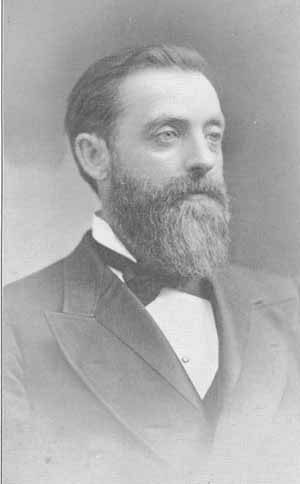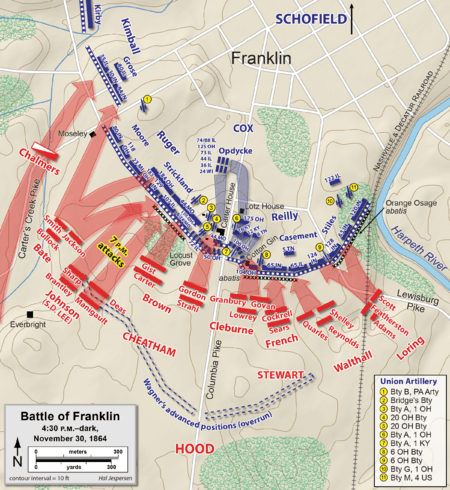John S. Casement facts for kids
Quick facts for kids
John Stephen Casement
|
|
|---|---|
 |
|
| Nickname(s) | "General Jack" |
| Born | January 19, 1829 Geneva, New York, US |
| Died | December 13, 1909 (aged 80) Painesville, Ohio, US |
| Place of burial |
Evergreen Cemetery, Painesville, Ohio
|
| Allegiance | United States of America Union |
| Service/ |
United States Army Union Army |
| Years of service | 1861 – 1865 |
| Rank | |
| Unit | 103rd Ohio Volunteer Infantry |
| Commands held | 2nd Brigade, 3rd Division, XXIII Corps. |
| Battles/wars | American Civil War |
| Other work | Directed the Union Pacific work crews during construction of the Transcontinental Railroad |
John Stephen "Jack" Casement (January 19, 1829 – December 13, 1909) was an important American figure. He was a general in the Union Army during the American Civil War. He was also a famous builder of railroads.
Casement led the construction of the Union Pacific Railroad's part of the First transcontinental railroad. This huge project connected the Western United States with the East.
Contents
Early Life and Building Railroads
John S. Casement was born in Geneva, New York, on January 19, 1829. His parents were Robert and Anna Casement. They came from the Isle of Man. John learned most of what he knew by himself.
In 1857, Casement married Frances Marion Jennings in Ohio. They had three sons.
Starting a Career in Railroads
In 1844, John's family moved to Michigan. There, Casement began working on railroads. He started as a laborer, helping to build tracks for the Michigan Central railroad.
By 1850, he moved to Ohio. He worked as a foreman, leading teams that built and maintained railroad tracks. He worked on several railroads, including the Cleveland, Columbus and Cincinnati Railroad.
In 1853, Casement started his own business. He became a railroad contractor. This meant his company was hired to build parts of railroads. He worked on projects like adding more tracks to the Lake Shore railroad.
Before the Civil War began, he and his brother, Daniel, built tracks for other railroads. When the war started, John Casement joined the army. He left his brother in charge of their business.
Serving in the Civil War
When the Civil War began, John Casement quickly volunteered to serve. He joined the Seventh Ohio Volunteer Infantry. He was chosen to be a major in his regiment.
After serving for ninety days, he decided to stay in the army for three more years. His first battle was at Kessler's Cross Lanes in Virginia in 1861. Even though his side was surprised, Casement led his men safely through enemy land.
He also fought in the Shenandoah Valley against Confederate soldiers led by Stonewall Jackson. After showing great bravery at the First Battle of Kernstown in 1862, Casement was promoted. He became a colonel and led the new 103rd Ohio Volunteer Infantry.
Key Battles and Promotions
Casement led his regiment during the first part of the Atlanta Campaign in 1864. During the Siege of Atlanta, he took command of a larger group of soldiers called the 2nd Brigade.
His brigade played a very important role at the Battle of Franklin on November 30, 1864. Confederate forces attacked the Union lines many times. Casement's brigade was at the center of the Union defense.
The Confederates attacked with thousands of soldiers, but Casement's men held their ground. They fought off all the attacks, causing heavy losses for the enemy. His commanding officer, Jacob D. Cox, said that Casement "saved the day for the Union."
Because of his brave actions, Casement was promoted to brigadier general in January 1865. One of his soldiers said that Casement was loved by his men. They would have "died for him at any time."
Later, Casement's brigade was moved to North Carolina. He took part in the Battle of Wilmington. This was his last major battle. He left the army on April 30, 1865.
After the War: Building America's Railroads
After the Civil War, Casement went back to building railroads. In 1866, he and his brother Daniel were hired by the Union Pacific Railroad. Their job was to direct the construction of the First transcontinental railroad.
Daniel Casement handled the money side of the business. John, known as "General Jack" by his crews, led the workers. They oversaw the building of the railroad from Fremont, Nebraska, all the way to its completion in Promontory, Utah.
The Golden Spike and More Railroads
There's a famous story about the "Golden Spike." This spike was hammered in to mark the completion of the transcontinental railway. The story says that Leland Stanford, a railroad president, couldn't hit the spike properly. Casement supposedly took the hammer and drove it in himself. However, this story might not be true.
After finishing the transcontinental railway, Casement kept building more railroads. In 1870, he helped rebuild the Union & Titusville Railroad. He also worked on the Wabash Railroad and the Nickel Plate railroad. By 1885, Casement claimed he had built more miles of railroad track than anyone else in the United States.
He even helped build a railroad in Costa Rica in 1897.
In 1906, Casement was in San Jose, California, when the big 1906 San Francisco earthquake hit. He was hurt but survived. However, he never fully recovered his health.
John S. Casement passed away in Painesville, Ohio, on December 13, 1909. Casement Airport in Painesville and a World War II ship were named in his honor.
Hell on Wheels: A Railroad Town
The groups of rail workers and others who followed the railroad construction were called "Hell on Wheels." This name described the busy, rough daily life at the end of the tracks. The term is also used for a TV show, Hell on Wheels. In the show, the main character, Cullen Bohannon, is partly based on Casement's life.
See also
Images for kids
-
General John S. Casement and His Outfit (1867-8). Photo by Andrew J. Russell.



